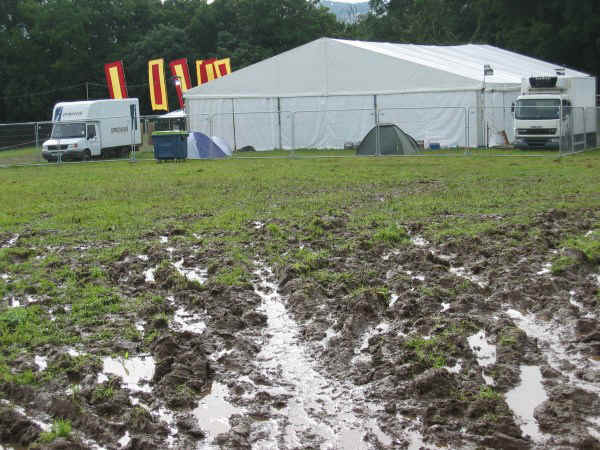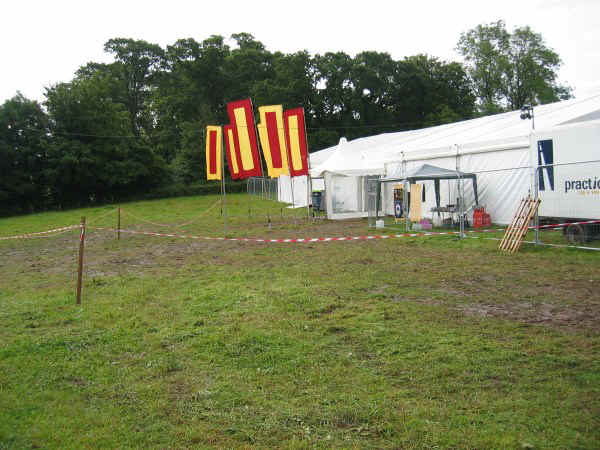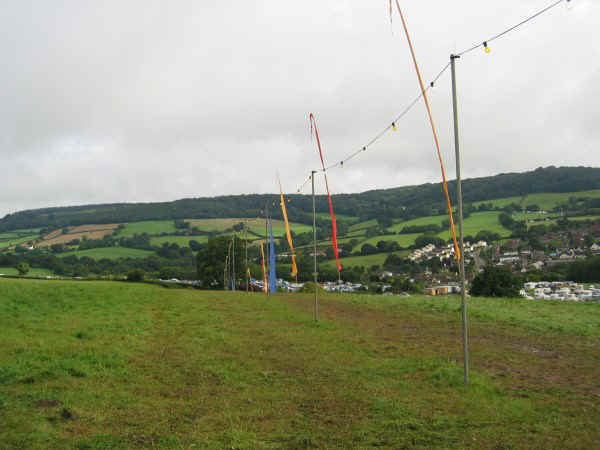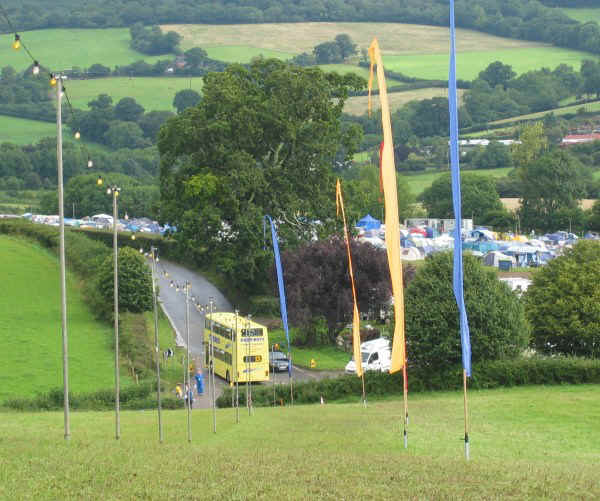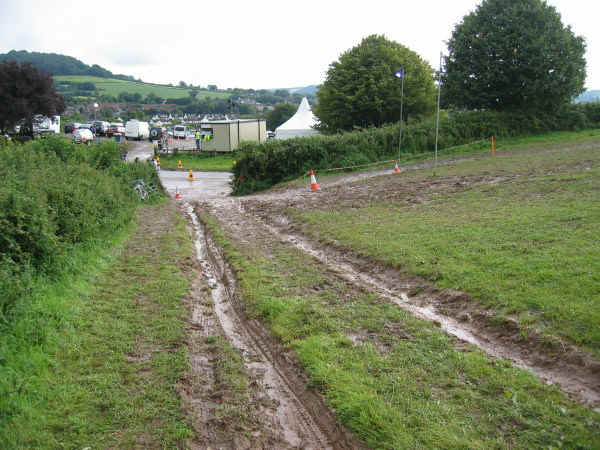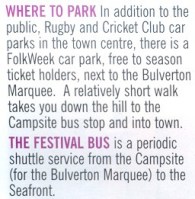"The trouble with both
the Bulverton and the Blackmore Garden ceilidh marquees is that there is very little space
for people who aren't dancing, not everyone wants to or can dance every dance and needs to
sit down or have a rest which is difficult when you're squeezed in."
The paradox at the Bulverton is that, last year, the space set aside for that purpose was
hardly used. It's hard to justify the extra space when the majority of it is sat empty
throughout the week. Even this year, when I wanted a place to sit down up at the Bulverton
I could usually find one (though maybe not the same seat all night). I think the one thing
we didn't accommodate so much this year is the rows and rows of empty chairs which act
mainly as a repository for ceilidh dancers' bags, jumpers etc. While I can understand that
it is nice to know you have a "saved" seat to go back to when you want to sit a
dance out, it costs a lot to create that extra space.
To be perfectly honest, this year was a
make-or-break year for the Bulverton. It has been a loss-leader for the festival for
several years, and if we didn't make it work this year, we risked losing it altogether. The strategy for addressing this was to rejuvenate
the programme while reducing the costs, and to re-evaluate our catering partners in order
to maximise the return on the secondary spend (bar and food) to the festival.
In reducing the size of the venue, we looked at ways of doing this while compromising the
dance experience as little as possible. That's why the dance floor itself only lost 2
metres, while the space that was lost was the "sidelines" space. As I say, when
I wanted to sit down this year, I usually found there was a seat available. It might have
someone else's jumper over the back, but I moved if they returned. I think that a slightly
more adaptable approach by ceilidh dancers in this respect will mean that the space is
used to its fullest potential (and value).
So, to sum up, it isn't a case of "We'd like the big marquee back, please." It's a case of making the size of marquee work as it
is, or not having a Bulverton at all. Having
said that, as I said earlier in my post, our infrastructure team is looking at ways of
using the space up there differently next year in order to create more
chatting-and-standing-about space which is under cover.
We have similar issues with Blackmore, but again, the team is looking at ways of creating
more undercover space for next year.
Use of the Bulverton marquee varied enormously - as in previous years. At peak capacity
apparently 800 people attended the Peatbog Faeries - an absurdly high number if anyone
actually expected to be able to dance! The dance floor area was about 170 m2
and could accommodate up to 170 for set dances and maybe 250 for
close proximity disco dance. Beyond that it would have been collisions all round. The LNE
on the Wednesday with the Old Swan Band produced excellent dance music - but it seemed to
be of limited interest to many youngsters and there was (for once) room to dance. With 100
people actually on the dance floor it was very comfortable - 150 would have been no
problem for many dances. The Monday LNE with Oyster Ceilidh band was LOUD, packed and with
no room to dance.
At the other end of the scale the Mega Contra on the Wednesday afternoon attracted a
maximum of 12 people - the event was abandoned after an hour. This could have been
predicted - despite the popularity of contra dance there was really too much of it at
Sidmouth in 2009. Anyone who was keen would have been 'danced out' by the Wednesday
afternoon. In any case, this was the only day of good sunshine. Everyone with any sense
went to the beach. This happened once before in Sidmouth during the early days of the
'new' festival when the late Mick Brookes was calling a ceilidh in the Ham marquee at
lunchtime. About 12 people attended. Everyone else was on the beach - this being the first
sunshine of the week.
If weather conditions had been less good for the Mega Contra in 2009, the event would
still have been a flop. Who would have trudged in the rain and mud to the Bulverton for
yet more contra dancing when a surfeit was available both in dance halls in town and in
the Blackmore Gardens marquee - and (for men) with Wendy Graham as an added attraction?
The organisers simply got this badly wrong - and there is a lesson for the future.
Afternoon events in the Bulverton will only attract sizeable numbers of people if they are
specialised and available no-where else during the week. A good example was the Jewish
dance workshop held on the Tuesday afternoon - a day when it rained almost non-stop for
about 12 hours.
The ground conditions were utterly appalling, worse than shown in any of my
photographs. The band and caller (locally based Spinach for Norman and caller Pam Hayes
both of whom are popular amongst serious dancers) struggled to get their equipment into
the venue. They were rewarded with an attendance between 35 and 65 at the peak. Many of
these people had come specifically to learn this specialised dance - and nothing (not even
Bulverton in heavy rain) would have deterred them. Pam Hayes was both delighted and amazed
at the turnout.
A similar number (but maximum 35) turned out for the Dartmoor Pixies 'extra event' on
the Saturday afternoon. It should have been made clear in the programme this was not a
dance or ceilidh - it turned out to be a bit of a damp squib for dance (maximum 16
dancers?) but enlivened by the Kelly Quarry Blasters. Again, it was not unusual enough to
attract many people up to Bulverton.
Another specialised dance workshop - the Eurodance and including the Fandango with
Kerry Fletcher attracted enough people to make it worthwhile - again about 60. Many people
used cars to come to this - if the festival car park had been closed then it might have
been a flop.
Another example of the popularity of specialised dance was the Breton and French event
held at All Saints Hall on the Wednesday, and featuring the d'Accord group from Devon.
This was not part of the festival (why not, we need to ask?). Despite the extra admission
charge of £4.50 the hall attracted a large number of people - all keen to learn and to
dance properly. Given the number of attendees (year on year) this really does need to
become more a part of the main festival - it has far more artistic merit than many of the
'hard rock' and 'headbanging' ceilidh bands that Joan Crump seems to favour. Maybe it is
thought too much to expect that the 'yoof' she seems so keen to indulge would actually
bother to try and learn something?
The people who ran this event are also owed an apology by the festival organisers for
the mishandling of their Bulverton early evening event on the Sunday. It was originally
billed as a repeat of the hugely popular Cornish and Breton dance evening of 2008. This
also suffered from administrative problems with the rescheduled
Blackmore Gardens venue being both too hot (despite a cool night) and packed well beyond
dancing capacity. The 2009 repeat event at the Bulverton was scheduled originally for 4 or
5 hours. The bands and callers are local - Dalla from Cornwall and Poisson Rouge from
Devon - and Folk Week tries hard to communicate that it owes allegiance to the local
community. Maybe as gesture politics only?
The timing was changed at short notice to only 2 hours - and it appeared in the working
programme as an 8 to 10pm item. The bands had got together, agreed that 2 hours was an
absurdly short time and it was agreed that they would start at 7.30 - later changed to
7.15. Unfortunately few of us knew this - some people arrived an hour or more too early,
many arrived at 8pm to find half the evening already gone and no-one was best pleased.
This is the second year running that these popular and talented musicians and dancers have
been comprehensively messed about at Sidmouth. They deserve better treatment in future
years.
The event that followed - the 'silent disco' was another example of poor planning. The
venue had to be cleared because of the need to collect £5 in cash from all attendees (a
refundable deposit on the headphones and some people didn't have £5 in cash on them!)
Letting people back in was a slow process, made memorable by the attitude of one of the
security staff. Had it been raining hard, everyone would have got soaked before being
readmitted. Judged by the numbers attending (about 700 - to try out a novel event?) it was
a success, with Joan Crump ecstatic on the night. As a folk event - maybe.
The final LNE is usually well attended and (as usual) Hekety were too loud. The
Chequered Flag dance team were simply superb - we have come to expect nothing less! Most
of the ceilidh dancers were young but knew what they were doing. In early sets there were
only about 120 people on the dance floor - a comfortable number.
As usual, both the final LNE and the whole week ended far too soon.
next page
back to top of section
home page
